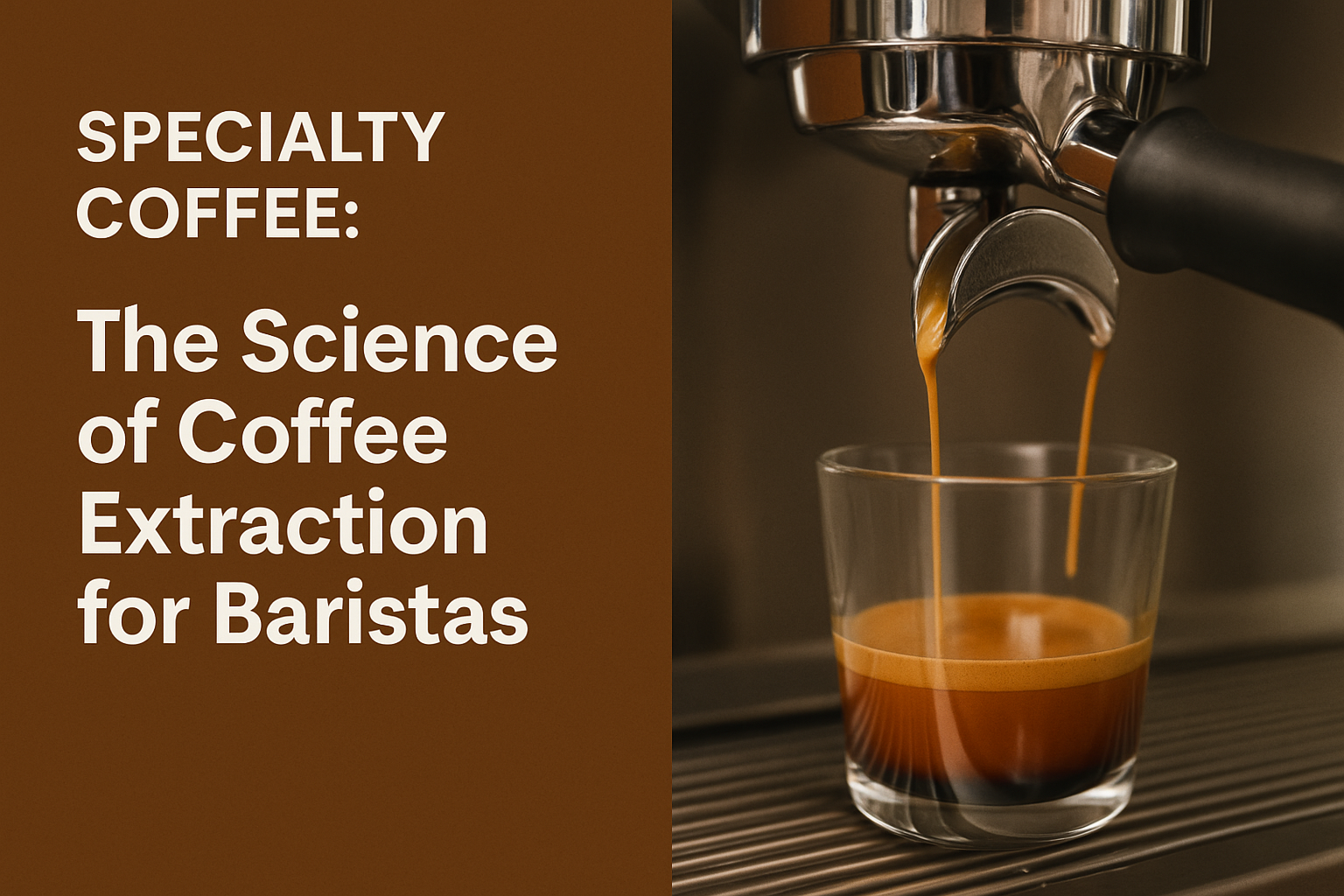If you want to become a great barista, mastering the science of coffee extraction is non-negotiable.
It’s not just about pressing buttons or following a recipe — it’s about understanding what’s happening inside the coffee bed and how small changes in grind size, brew time, and water temperature affect the final cup.
Extraction is what turns ground coffee and water into something flavorful, aromatic, and satisfying. When done right, it brings out balance, sweetness, and clarity. When done wrong, it leads to bitterness, sourness, or flatness.
In this guide, you’ll learn the core concepts of extraction, how to identify under- and over-extraction, and how to take control of your brew — whether you’re pulling espresso or preparing a pour-over.
What Is Coffee Extraction?
Extraction is the process of dissolving soluble compounds from coffee grounds into water. These compounds include:
- Acids (which bring brightness)
- Sugars (which bring sweetness)
- Oils (which contribute to body and texture)
- Bitter compounds (which add depth — or harshness if overdone)
When you brew coffee, water is pulling these elements out in a specific order. The goal is to extract enough of the good stuff — acids and sugars — without pulling too many bitter compounds at the end.
Baristas refer to the ideal range as “balanced extraction”, where all the elements come together in harmony.
Extraction Yield: The Technical Side
In professional settings, we measure extraction yield — the percentage of coffee solids that have been dissolved into water.
According to the Specialty Coffee Association (SCA):
- Optimal extraction yield: 18% to 22%
- Under-extracted: Below 18%
- Over-extracted: Above 22%
You don’t need a refractometer to brew great coffee, but knowing these numbers helps frame your decisions when adjusting your recipe.
Signs of Under-Extraction
When coffee is under-extracted, it means the water didn’t pull out enough of the desirable compounds. This often results in:
- Sour or sharp taste
- Lack of sweetness
- Thin or watery body
- Harsh acidity
Common causes:
- Grind is too coarse
- Brew time is too short
- Water temperature is too low
- Not enough agitation or turbulence
In short, your water passed through the grounds too quickly or didn’t make enough contact to extract flavor.
Signs of Over-Extraction
Over-extraction happens when you pull too much from the grounds — including the bitter and dry-tasting compounds at the end of the extraction process.
Signs include:
- Bitterness or astringency
- Dry or chalky finish
- Muted sweetness
- Hollow or empty flavor
Common causes:
- Grind is too fine
- Brew time is too long
- Water temperature is too high
- Too much coffee used
Over-extraction often happens when you try to “squeeze” more strength out of a weak brew by extending time or grinding finer — a common mistake.
Brew Strength vs Extraction
It’s important to understand that strength and extraction are not the same.
- Strength refers to the concentration of coffee in your brew (measured in TDS – total dissolved solids).
- Extraction refers to how much of the coffee material has been dissolved.
You can have a strong, over-extracted coffee that tastes bitter — or a weak, under-extracted one that tastes sour. The key is to balance both strength and extraction for the best result.
Core Variables That Control Extraction
Let’s look at the most important tools a barista can use to control extraction:
1. Grind Size
This is your most powerful adjustment tool.
- Finer grind = slower flow = more extraction
- Coarser grind = faster flow = less extraction
If your coffee tastes sour or thin, grind finer. If it tastes bitter or dry, grind coarser.
2. Brew Time
The longer the water stays in contact with the grounds, the more it extracts.
- Short brew time = under-extraction
- Long brew time = over-extraction
Each brew method has a recommended time range:
- Espresso: 25–35 seconds
- Pour-over: 2.5–4 minutes
- French press: 4 minutes
Use a timer for consistency.
3. Water Temperature
Water that’s too hot can pull out bitter compounds quickly. Water that’s too cool won’t extract enough.
- Ideal range: 90°C to 96°C (194°F to 205°F)
- For light roasts, lean hotter
- For dark roasts, stay cooler
Consistency is key. A kettle with temperature control is a worthy investment.
4. Coffee-to-Water Ratio
This affects both strength and extraction. A common starting point is:
- 1:15 to 1:17 for pour-over or immersion (e.g., 20g coffee to 300g water)
- 1:2 for espresso (e.g., 18g coffee in, 36g liquid out)
Changing the ratio affects how concentrated your brew is, but also how easily water can pass through the grounds.
5. Agitation and Pour Technique
How you pour the water — and how much you stir or swirl — impacts extraction.
- More agitation = more extraction
- Less agitation = gentler brew
In pour-over, use a controlled circular pour. In immersion methods like French press, stir briefly and evenly.
Too much agitation can lead to over-extraction or muddy flavors.
Dialing In: A Practical Process
Dialing in a coffee means finding the perfect balance of grind, time, and ratio for a specific bean and brew method. Here’s a simple process:
- Brew a test cup
- Taste it
- Identify the problem (sour? bitter? weak?)
- Make one change at a time
- Brew again and compare
Keep notes. Over time, you’ll begin to predict how changes will affect flavor — that’s when you start thinking like a true barista.
Common Extraction Issues by Brew Method
Each method has unique challenges:
Espresso
- Too fast = sour, weak shot (under-extracted)
- Too slow = bitter, dry shot (over-extracted)
- Channeling (uneven water flow) can cause both in one cup
Tamp evenly, check your dose, and monitor time and yield.
Pour-Over
- Uneven pouring = inconsistent extraction
- Wrong grind size = off-balance flavors
Use a gooseneck kettle for better control and always bloom the coffee before brewing.
French Press
- Too fine grind = sludgy, over-extracted
- Too coarse grind = weak, sour cup
Stir gently and plunge after 4 minutes. Decant immediately to stop brewing.
Cold Brew
- Under-extracted cold brew is sharp and sour
- Over-extracted is bitter and overly woody
Use a coarse grind, 12–18 hour steep, and taste before serving.
How Roast Affects Extraction
Light roasts are denser and more resistant to water. They require:
- Finer grind
- Hotter water
- Longer brew time
Dark roasts extract more quickly and can become bitter fast. They need:
- Coarser grind
- Lower temperatures
- Shorter brew times
Always adjust your technique to match the roast level.
Final Thoughts: Extraction Is a Journey, Not a Formula
Extraction is the heart of the brewing process. It’s where science meets intuition, and where the barista has the most control over the final flavor.
Great baristas don’t memorize one recipe — they observe, taste, and adjust. They understand how each variable works, and they use that knowledge to create something delicious every time.
So next time you brew, think like a scientist and taste like an artist. Because the real magic of coffee doesn’t happen in the bean — it happens in the extraction.

Marcelo Rodrigues is a passionate barista with over 7 years of experience in specialty coffee. He’s worked in top cafés, led barista training sessions, and now shares practical tips to help beginners and coffee lovers improve their skills. Through this blog, Marcel makes the world of coffee more accessible—one cup at a time.

